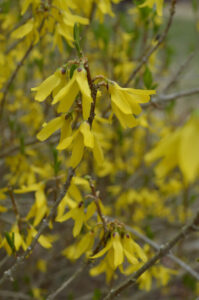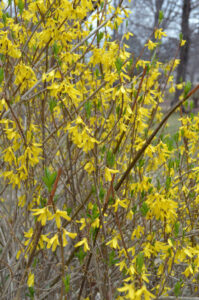Forsythia (Forsythia x intermedia) is a non-native, deciduous, woody ornamental shrub. It provides only a little wildlife benefit, but it is suitable for soil retention and a privacy barrier and is a fast grower.
It is an early spring bloomer and provides bright yellow to the landscape when there isn’t much other color. Flowers are profuse and bell-shaped, appearing in March through April before the leaves begin to grow.
Several cultivars vary in size of the flower, size of the shrub, and growth habit (erect or weeping). Forsythia intermedia is the most common type in the Southeast.
When to Prune
If you don’t mind the natural look of the shrub (stems will protrude in every direction), there is no need to trim it back. However, trim the old branches just after the plant has finished flowering if you want to shape the shrub. Flowers form on the previous year’s new growth.
How to grow Forsythia
For the showiest blooms, plant Forsythia in full sun in well-drained soil though it can tolerate various soil types and even part-shade. It can be grown in zones 3-8 and will grow as tall as 10 feet and equally as wide. After it is established, it can tolerate drought conditions.
Propagating Forsythia
Forsythia can be rooted from softwood cuttings. Here is a quick guide on taking and growing cuttings: http://www.bhg.com/gardening/yard/garden-care/starting-flowers-from-cutting/
Wildlife uses
Since it is from Asia, native wildlife does not make much use of this shrub. I have seen some reports of bees and butterflies getting nectar from the flowers, while others claim the bees ignore their shrubs. I have not noticed any bee activity around the shrub in my garden.
The shrub is deer-resistant, and perhaps its best wildlife use is for cover for birds and rodents. Every time I go near the one bush in my yard, a bird or two scurries from underneath it.
I also came across a report from the Georgia Department of Natural Resources that states that house finches eat the buds and blossoms of this shrub.
Note: There is another yellow-blooming shrub that could be confused with Forsythia: winter jasmine. The difference is this is not a woody shrub, the stems are green, and the flowers are much smaller. Also, the jasmine begins to flower before the Forsythia (as early as November).
Resources
Learn more about Forsythia here: http://www.clemson.edu/extension/hgic/plants/landscape/shrubs/hgic1064.html



